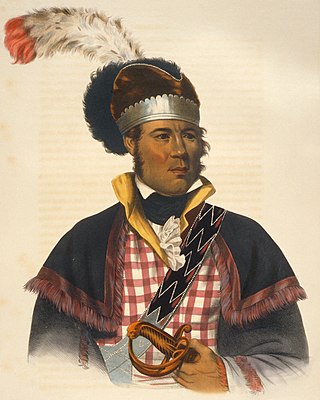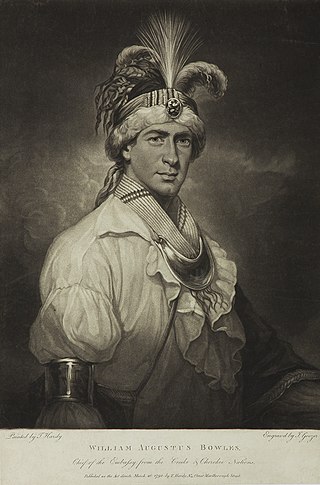Related Research Articles

France began colonizing the Americas in the 16th century and continued into the following centuries as it established a colonial empire in the Western Hemisphere. France established colonies in much of eastern North America, on several Caribbean islands, and in South America. Most colonies were developed to export products such as fish, rice, sugar, and furs.

The Muscogee, also known as the Mvskoke, Muscogee Creek, and the Muscogee Creek Confederacy, are a group of related Indigenous peoples of the Southeastern Woodlands in the United States of America. Their historical homelands are in what now comprises southern Tennessee, much of Alabama, western Georgia and parts of northern Florida.

Conecuh County is a county located in the south central portion of the U.S. state of Alabama. As of the 2020 census the population was 11,597. Its county seat is Evergreen. Its name is believed to be derived from a Creek Indian term meaning "land of cane."

Wetumpka is a city in and the county seat of Elmore County, Alabama, United States. At the 2020 census, the population was 7,220. In the early 21st century Elmore County became one of the fastest-growing counties in the state. The city is considered part of the Montgomery Metropolitan Area.

The Creek War, was a regional conflict between opposing Native American factions, European powers, and the United States during the early 19th century. The Creek War began as a conflict within the tribes of the Muscogee, but the United States quickly became involved. British traders and Spanish colonial officials in Florida supplied the Red Sticks with weapons and equipment due to their shared interest in preventing the expansion of the United States into regions under their control.

Alexander McGillivray, also known as Hoboi-Hili-Miko, was a Muscogee (Creek) leader. The son of a Muscogee mother and a Scottish father, he was literate and educated, and understood the "white" European world and merchandise trading well. These gave him prestige, especially with European Americans, who were glad to finally find a Creek leader they could talk to and deal with. He used his role as link between the two worlds to his advantage, not always fairly, and became the richest Creek of his time.

William Weatherford, also known after his death as Red Eagle, was a Creek chief of the Upper Creek towns who led many of the Red Sticks actions in the Creek War (1813–1814) against Lower Creek towns and against allied forces of the United States.

The Atakapa or Atacapa were an indigenous people of the Southeastern Woodlands, who spoke the Atakapa language and historically lived along the Gulf of Mexico in what is now Texas and Louisiana. They included several distinct bands.
Lachlan McGillivray was a prosperous fur trader and planter in colonial Georgia with interests that extended from Savannah to what is now central Alabama. He was the father of Alexander McGillivray and the great-uncle of William McIntosh and William Weatherford, three of the most powerful and historically important Native American chiefs among the Creek of the Southeast.

Louisiana or French Louisiana was an administrative district of New France. Under French control from 1682 to 1769 and 1801 (nominally) to 1803, the area was named in honor of King Louis XIV, by French explorer René-Robert Cavelier, Sieur de la Salle. It originally covered an expansive territory that included most of the drainage basin of the Mississippi River and stretched from the Great Lakes to the Gulf of Mexico and from the Appalachian Mountains to the Rocky Mountains.

William McIntosh, was also commonly known as Tustunnuggee Hutke, was one of the most prominent chiefs of the Creek Nation between the turn of the nineteenth century and his execution in 1825. He was a chief of Coweta town and commander of a mounted police force. He became a large-scale planter, built and managed a successful inn, and operated a commercial ferry business. Early American historians attributed McIntosh's achievements and influence to his mixed race Scots/European ancestry. Since the late 20th century, historians have argued much of McIntosh's political influence stemmed more from his Creek upbringing and cultural standing, particularly his mother's prominent Wind Clan in the Creek matrilineal system, and to other aspects of Creek culture.

William Augustus Bowles (1763–1805), also known as Estajoca, was a Maryland soldier and adventurer. Seeing action as a Loyalist during the Revolutionary War, Bowles later formed an alliance with the Muscogee people and attempted to establish an independent indigenous American state with British support.
Jean Baptiste Louis DeCourtel Marchand, aka Captain Francois Marchand de Courcelles, was an eighteenth century French officer that served in the French colonies in America, and died after a second tour or duty ending in 1734. Marchand fathered two children with Sehoy, a daughter of the matrilineal Wind Clan of the Creek Nation, during his time in Alabama: Chief Red Shoes and Sehoy II Marchand (1722-1785), herself mother of Sehoy III McPherson and Creek Chief Alexander McGillivray. Moreover William Weatherford, the notorious Red Eagle, and his half-brother the mestizo Charles Weatherford were the sons of Sehoy III.
Red Shoes was a Muskogean leader of the Tuskegee people in the 18th century. He primarily lived in modern Alabama near Tuskegee at the forks of the Alabama River, but his influence extended well into modern Mississippi.

Fort Toulouse and Fort Jackson are two forts that shared the same site at the fork of the Coosa River and the Tallapoosa River, near Wetumpka, Alabama.

The Canoe Fight was a skirmish between Mississippi Territory militiamen led by Captain Samuel Dale and Red Stick warriors that took place on November 12, 1813 as part of the Creek War. The skirmish was fought largely from canoes and was a victory for the militiamen, who only had one member wounded. The victory held little military value in the overall Creek War but its participants gained widespread notoriety for their actions during the fight. The fight has been depicted in multiple illustrations, but only a historical marker currently exists near the site of the fight.
Jean Antoine Joseph Fauchet was a French diplomat, and French ambassador to the United States.

Murder Creek is a tributary of the lower Conecuh River. It is primarily located in Conecuh County, Alabama.
Sophia Durant was a Koasati Native American plantation owner, who served as the speaker, interpreter, and translator for her brother, Alexander McGillivray, a leader in the Muscogee Confederacy.
Sehoy, or Sehoy I, was an 18th-century matriarch of the Muscogee Confederacy and a member of the Wind clan.
References
- 1 2 3 4 5 6 7 8 Darius Alexander Spieth, "Louis Milfort", in Napoleon's Sorcerers: The Sophisians, Associated University Presse, 2007, pp. 153-154
- 1 2 "Notes and Documents: Milfort's Plan for a Franco-Creek Alliance and the Retrocession of Louisiana", ed. by E. Wilson Lyon, The Journal of Southern History, Vol. 4 No. 1, February 1938, JSTOR Journal Archive, accessed 15 September 2011
- ↑ web.genealogie Archived December 22, 2007, at the Wayback Machine